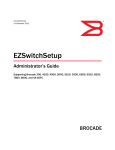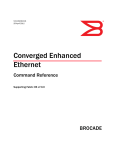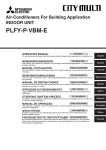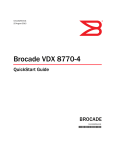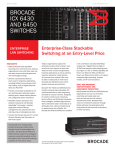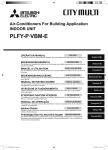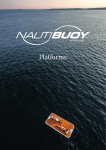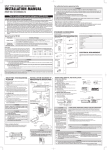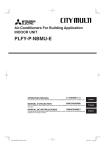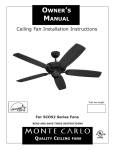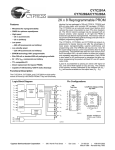Download Brocade Communications Systems Brocade Network OS 2.1 User's Manual
Transcript
53-1002606-06 18 January 2013 Network OS Documentation Updates Supporting Network OS v2.1.x ® Copyright © 2012 Brocade Communications Systems, Inc. All Rights Reserved. Brocade, Brocade Assurance, the B-wing symbol, BigIron, DCX, Fabric OS, FastIron, MLX, NetIron, SAN Health, ServerIron, TurboIron, VCS, and VDX are registered trademarks, and AnyIO, Brocade One, CloudPlex, Effortless Networking, ICX, NET Health, OpenScript, and The Effortless Network are trademarks of Brocade Communications Systems, Inc., in the United States and/or in other countries. Other brands, products, or service names mentioned may be trademarks of their respective owners. Notice: This document is for informational purposes only and does not set forth any warranty, expressed or implied, concerning any equipment, equipment feature, or service offered or to be offered by Brocade. Brocade reserves the right to make changes to this document at any time, without notice, and assumes no responsibility for its use. This informational document describes features that may not be currently available. Contact a Brocade sales office for information on feature and product availability. Export of technical data contained in this document may require an export license from the United States government. The authors and Brocade Communications Systems, Inc. shall have no liability or responsibility to any person or entity with respect to any loss, cost, liability, or damages arising from the information contained in this book or the computer programs that accompany it. The product described by this document may contain “open source” software covered by the GNU General Public License or other open source license agreements. To find out which open source software is included in Brocade products, view the licensing terms applicable to the open source software, and obtain a copy of the programming source code, please visit http://www.brocade.com/support/oscd. Brocade Communications Systems, Incorporated Corporate and Latin American Headquarters Brocade Communications Systems, Inc. 130 Holger Way San Jose, CA 95134 Tel: 1-408-333-8000 Fax: 1-408-333-8101 E-mail: [email protected] Asia-Pacific Headquarters Brocade Communications Systems China HK, Ltd. No. 1 Guanghua Road Chao Yang District Units 2718 and 2818 Beijing 100020, China Tel: +8610 6588 8888 Fax: +8610 6588 9999 E-mail: [email protected] European Headquarters Brocade Communications Switzerland Sàrl Centre Swissair Tour B - 4ème étage 29, Route de l'Aéroport Case Postale 105 CH-1215 Genève 15 Switzerland Tel: +41 22 799 5640 Fax: +41 22 799 5641 E-mail: [email protected] Asia-Pacific Headquarters Brocade Communications Systems Co., Ltd. (Shenzhen WFOE) Citic Plaza No. 233 Tian He Road North Unit 1308 – 13th Floor Guangzhou, China Tel: +8620 3891 2000 Fax: +8620 3891 2111 E-mail: [email protected] Document History Title Publication number Summary of changes Date Network OS Documentation Update 53-1002606-01 New document April 2012 Network OS Documentation Update 53-1002606-02 Added information for Network OS v2.1.1b June 2012 Network OS Documentation Update 53-1002606-03 Updated qos flowcontrol command July 2012 Network OS Documentation Update 53-1002606-04 Updated qos flowcontrol command July 2012 Network OS Documentation Update 53-1002606-05 Added information for Network OS v2.1.2 November 2012 Network OS Documentation Update 53-1002606-06 updated description for "chassis fan airflowdirection" command January 2013 Contents About This Document How this document is organized . . . . . . . . . . . . . . . . . . . . . . . . . . . . . v Supported hardware and software . . . . . . . . . . . . . . . . . . . . . . . . . . . v What’s new in this document . . . . . . . . . . . . . . . . . . . . . . . . . . . . . . . . vi Document conventions . . . . . . . . . . . . . . . . . . . . . . . . . . . . . . . . . . . . . vi Text formatting . . . . . . . . . . . . . . . . . . . . . . . . . . . . . . . . . . . . . . . .vi Command syntax conventions . . . . . . . . . . . . . . . . . . . . . . . . . . .vi Notes, cautions, and warnings . . . . . . . . . . . . . . . . . . . . . . . . . . vii Key terms . . . . . . . . . . . . . . . . . . . . . . . . . . . . . . . . . . . . . . . . . . . vii Notice to the reader . . . . . . . . . . . . . . . . . . . . . . . . . . . . . . . . . . . . . . viii Additional information. . . . . . . . . . . . . . . . . . . . . . . . . . . . . . . . . . . . . viii Brocade resources . . . . . . . . . . . . . . . . . . . . . . . . . . . . . . . . . . . . viii Other industry resources . . . . . . . . . . . . . . . . . . . . . . . . . . . . . . . viii Getting technical help . . . . . . . . . . . . . . . . . . . . . . . . . . . . . . . . . . . . . . ix Document feedback . . . . . . . . . . . . . . . . . . . . . . . . . . . . . . . . . . . . . . . ix Chapter 1 NOS Administrator’s Guide New Content for the NOS Administrator’s Guide . . . . . . . . . . . . . . . . 1 Chapter 6, Installing and Maintaining Firmware. . . . . . . . . . . . . . . . . 1 Chapter 8, Security . . . . . . . . . . . . . . . . . . . . . . . . . . . . . . . . . . . . . . . . 2 Chapter 9, FIPS Support . . . . . . . . . . . . . . . . . . . . . . . . . . . . . . . . . . . . 3 Chapter 15, Configuration Management. . . . . . . . . . . . . . . . . . . . . . . 3 Chapter 23, Configuring LLDP . . . . . . . . . . . . . . . . . . . . . . . . . . . . . . . 4 Chapter 2 NOS CLI Command Reference New commands in the Network OS Command Reference. . . . . . . . . 5 Modified commands in Network OS Command Reference . . . . . . . 10 Deleted commands in Network OS Command Reference . . . . . . . . 22 Chapter 3 Network OS Message Reference New messages . . . . . . . . . . . . . . . . . . . . . . . . . . . . . . . . . . . . . . . . . . 23 EM System Messages . . . . . . . . . . . . . . . . . . . . . . . . . . . . . . . . . 23 FW System Messages . . . . . . . . . . . . . . . . . . . . . . . . . . . . . . . . . 24 PORT System Messages . . . . . . . . . . . . . . . . . . . . . . . . . . . . . . . 24 VC System Messages. . . . . . . . . . . . . . . . . . . . . . . . . . . . . . . . . . 25 Network OS Documentation Update 53-1002606-06 iii Modified messages. . . . . . . . . . . . . . . . . . . . . . . . . . . . . . . . . . . . . . . 27 Chapter 4 Brocade VDX 6710-54 Hardware Reference Manual Chapter 4, Brocade VDX 6710-54 Operation . . . . . . . . . . . . . . . . . . 29 Chapter 5, FRU Removal and Replacement Procedures . . . . . . . . . 29 Chapter 5 Brocade VDX 6720 Hardware Reference Manual Chapter 4, Brocade VDX 6720 Operation . . . . . . . . . . . . . . . . . . . . . 31 Chapter 5, FRU Removal and Replacement Procedures . . . . . . . . . 31 Chapter 6 Brocade VDX 6730 Hardware Reference Manual Chapter 4, Brocade VDX 6730 Operation . . . . . . . . . . . . . . . . . . . . . 33 Chapter 5, FRU Removal and Replacement Procedures . . . . . . . . . 33 iv Network OS Documentation Update 53-1002606-06 About This Document In this chapter • How this document is organized . . . . . . . . . . . . . . . . . . . . . . . . . . . . . . . . . . . v • Supported hardware and software. . . . . . . . . . . . . . . . . . . . . . . . . . . . . . . . . . v • What’s new in this document . . . . . . . . . . . . . . . . . . . . . . . . . . . . . . . . . . . . . . vi • Document conventions . . . . . . . . . . . . . . . . . . . . . . . . . . . . . . . . . . . . . . . . . . . vi • Notice to the reader . . . . . . . . . . . . . . . . . . . . . . . . . . . . . . . . . . . . . . . . . . . . viii • Additional information . . . . . . . . . . . . . . . . . . . . . . . . . . . . . . . . . . . . . . . . . . . viii • Getting technical help . . . . . . . . . . . . . . . . . . . . . . . . . . . . . . . . . . . . . . . . . . . . ix • Document feedback . . . . . . . . . . . . . . . . . . . . . . . . . . . . . . . . . . . . . . . . . . . . . ix How this document is organized This document contains updates to the following Network OS manuals: • “NOS Administrator’s Guide” on page 1. • “NOS CLI Command Reference” on page 5. • “Network OS Message Reference” on page 23. Supported hardware and software This document includes updated information specific to Network OS v2.1.x. The following hardware platforms are supported in this release: • Brocade VDX 6710 • BrocadeVDX 6720 • BrocadeVDX 6730 Although many different software and hardware configurations are tested and supported by Brocade Communications Systems, Inc. for Network OS v2.1.x, documenting all possible configurations and scenarios is beyond the scope of this document. To obtain information about an OS version other than Network OS v2.1.x, refer to the documentation specific to that OS version. Network OS Documentation Update 53-1002606-06 v What’s new in this document This document has been updated for Network OS v2.1.2 with information on: • • • • restrict-flooding command vCenter discovery commands Added the new and modified messages in Chapter 3, “Network OS Message Reference”. Revised description for the “chassis fan airflow-direction” command in Chapter 2, “NOS CLI Command Reference”. Document conventions This section describes text formatting conventions and important notice formats used in this document. Text formatting The narrative-text formatting conventions that are used are as follows: bold text Identifies command names Identifies the names of user-manipulated GUI elements Identifies keywords and operands Identifies text to enter at the GUI or CLI italic text Provides emphasis Identifies variables Identifies paths and Internet addresses Identifies document titles code text Identifies CLI output Identifies command syntax examples For readability, command names in the narrative portions of this guide are presented in mixed lettercase: for example, switchShow. In actual examples, command lettercase is often all lowercase. Otherwise, this manual specifically notes those cases in which a command is case sensitive. Command syntax conventions Command syntax in this manual follows these conventions: vi command Commands are printed in bold. --option, option Command options are printed in bold. -argument, arg Arguments. [] Optional element. variable Variables are printed in italics. In the help pages, values are underlined or enclosed in angled brackets < >. Network OS Documentation Update 53-1002606-06 ... Repeat the previous element, for example “member[;member...]” value Fixed values following arguments are printed in plain font. For example, --show WWN | Boolean. Elements are exclusive. Example: --show -mode egress | ingress Notes, cautions, and warnings The following notices and statements are used in this manual. They are listed below in order of increasing severity of potential hazards. NOTE A note provides a tip, guidance, or advice, emphasizes important information, or provides a reference to related information. ATTENTION An Attention statement indicates potential damage to hardware or data. CAUTION A Caution statement alerts you to situations that can be potentially hazardous to you or cause damage to hardware, firmware, software, or data. DANGER A Danger statement indicates conditions or situations that can be potentially lethal or extremely hazardous to you. Safety labels are also attached directly to products to warn of these conditions or situations. Key terms For definitions specific to Brocade and Fibre Channel, see the technical glossaries on MyBrocade. See “Brocade resources” on page viii for instructions on accessing MyBrocade. For definitions of SAN-specific terms, visit the Storage Networking Industry Association online dictionary at: http://www.snia.org/education/dictionary Network OS Documentation Update 53-1002606-06 vii Notice to the reader This document may contain references to the trademarks of the following corporations. These trademarks are the properties of their respective companies and corporations. These references are made for informational purposes only. Corporation Referenced Trademarks and Products Microsoft Corporation Windows, Windows NT, Internet Explorer Oracle Corporation Oracle, Java Red Hat, Inc. Red Hat, Red Hat Network, Maximum RPM, Linux Undercover IBM BladeCenter Advanced Management Module Protect Mode Additional information This section lists additional Brocade and industry-specific documentation that you might find helpful. Brocade resources To get up-to-the-minute information, go to http://my.brocade.com and register at no cost for a user ID and password. White papers, online demonstrations, and data sheets are available through the Brocade website at: http://www.brocade.com/products-solutions/products/index.page For additional Brocade documentation, visit the Brocade website: http://www.brocade.com Release notes are available on the MyBrocade website and are also bundled with the Network OS firmware. Other industry resources For additional resource information, visit the Technical Committee T11 website. This website provides interface standards for high-performance and mass storage applications for Fibre Channel, storage management, and other applications: http://www.t11.org For information about the Fibre Channel industry, visit the Fibre Channel Industry Association website: http://www.fibrechannel.org viii Network OS Documentation Update 53-1002606-06 Getting technical help Contact your switch support supplier for hardware, firmware, and software support, including product repairs and part ordering. To expedite your call, have the following information available: 1. General Information • • • • • • Switch model Switch operating system version Software name and software version, if applicable Error numbers and messages received supportSave command output Detailed description of the problem, including the switch or fabric behavior immediately following the problem, and specific questions • Description of any troubleshooting steps already performed and the results • Serial console and Telnet session logs • syslog message logs 2. Switch Serial Number The switch serial number and corresponding bar code are provided on the serial number label, as illustrated below: FT00X0054E9 FT00X0054E9 The serial number label is located as follows: • Brocade VDX 6720 — On the switch ID pull-out tab located on the bottom of the port side of the switch 3. World Wide Name (WWN) Use the licenseIdShow command to display the WWN of the chassis. If you cannot use the licenseIdShow command because the switch is inoperable, you can get the WWN from the same place as the serial number, except for the Brocade DCX. For the Brocade DCX, access the numbers on the WWN cards by removing the Brocade logo plate at the top of the nonport side of the chassis. Document feedback Quality is our first concern at Brocade and we have made every effort to ensure the accuracy and completeness of this document. However, if you find an error or an omission, or you think that a topic needs further development, we want to hear from you. Forward your feedback to: [email protected] Provide the title and version number of the document and as much detail as possible about your comment, including the topic heading and page number and your suggestions for improvement. Network OS Documentation Update 53-1002606-06 ix x Network OS Documentation Update 53-1002606-06 Chapter NOS Administrator’s Guide 1 In this chapter • New Content for the NOS Administrator’s Guide. . . . . . . . . . . . . . . . . . . . . . . 1 New Content for the NOS Administrator’s Guide The updates in this chapter are for the Network OS Administrator’s Guide Supporting Network OS v2.1.1 (53-1002491-01), originally published in December 2011. NOTE The updates are arranged by the chapter names as they appear in the original document. Chapter 6, Installing and Maintaining Firmware Replace the section titled “Downloading firmware from a USB device” on page 56 with the following section. Downloading firmware from a USB device The Brocade VDX 6710, 6720, and 6730 switches support firmware download from a Brocade-branded USB device. Third-party USB devices are not supported. Before you can access the USB device, you must enable the device and mount it as a file system. The firmware images to be downloaded must be stored in the factory-configured firmware directory. Multiple images can be stored under this directory. 1. Ensure that the USB device is connected to the switch. 2. Enter the usb on command. switch# usb on Trying to enable USB device. Please wait... USB storage enabled 3. Optional: Enter the usb dir command. switch# usb dir firmwarekey\ 0B 2010 Aug 15 15:13 support\ 106MB 2010 Aug 24 05:36 config\ 0B 2010 Aug 15 15:13 firmware\ 380MB 2010 Aug 15 15:13 NOS_v2.1.1\ 379MB 2010 Aug 15 15:31 Available space on usbstorage 74% 4. Enter the firmware download usb command followed by the relative path to the firmware directory. Network OS Documentation Update 53-1002606-06 1 1 Chapter 8, Security switch# firmware download usb directory firmware\NOS_v2.1.1 5. Optional: Unmount the USB storage device. switch# usb off Trying to disable USB device. Please wait... USB storage disabled. Chapter 8, Security Add the following section after “TACACS+ server parameters” on page 86. This update only applies to Network OS v2.1.1b or higher: TACACS+ service in a mixed vendor environment Network OS v2.1.x supports Terminal Access Controller Access-Control System Plus (TACACS+) Authentication, Authorization and Accounting (AAA) services in multi vendor environments. Network OS v2.1.x utilizes Role Based Access Control (RBAC) to authorize access to system objects by authenticated users. In AAA environments you may need to configure “authorization” across Brocade & non-Brocade platforms. You can use TACACS+ to provide centralized AAA services to multiple Network Access Servers (NAS) or clients. Configuring optional arguments in tac_plus In Network OS v2.1.1b, the Attribute-Value Pair (AVP) arguement can be optional or mandatory, and is requested explicitly by the device running Network OS. In Network OS v2.1.1b, configure the argument as optional, as per the example below: brcd-role*admin To further enhance compatibility and interoperability with multiple TACACS+ services, the Network OS device sends the optional argument ‘brcd-role’ in the authorization request to the TACACS+ service. As most TACACS+ servers are coded so that if the NAS sends an argument (as mandatory or optional) in the authorization request, then the service sends the same argument in the response. So when brcd-role is configured as an optional argument, it is sent in the authorization request. Therefore Network OS users are able to successfully authorize with all TACACS+ services in a mixed vendor environment. The open source TACACS+ server ‘tac_plus’ is hosted on http://www.shrubbery.net, and is based on the original Cisco version of TACACS+ server. In the example below, the mandatory attribute priv-lvl=15 is set to allow Cisco to authenticate. The optional brcd-role = admin argument allows VDX to authenticate with Network OS v2.1.1b. NOTE As tac_plus does not send optional arguments by default, optional arguments are only supported by Network OS v2.1.1b or higher. To configure tac_plus with the optional attribute value pair for NOS, add these values to the tac_plus.conf file: user = <username> { default service = permit service = exec { priv-lvl=15 optional brcd-role = admin } 2 Network OS Documentation Update 53-1002606-06 1 Chapter 9, FIPS Support } Or group = <usergroup> { default service = permit service = exec { priv-lvl=15 optional brcd-role = admin } } user = <username> { Member = <usergroup> } Add the following note to the section “Adding a RADIUS server” on page 87: NOTE The maximum supported length for the RADIUS hostname is 40 characters. Add the following note to the section “Changing a RADIUS server” on page 87: NOTE The maximum supported length for the RADIUS hostname is 40 characters. Add the following note to the section “Adding a TACACS+ server” on page 87: NOTE The maximum supported length for the TACACS+ hostname is 40 characters. Add the following note to the section “Changing a TACACS+ server” on page 87: NOTE The maximum supported length for the TACACS+ hostname is 40 characters. Chapter 9, FIPS Support Add the following note to the section “Setting up LDAP for FIPS-compliant state” on page 110: NOTE The maximum supported length for the LDAP hostname is 40 characters. Chapter 15, Configuration Management Update the section “Setting interface parameters on a port” on page 176 to read as follows: Perform this procedure for every port you want to be monitored by ELD. Network OS Documentation Update 53-1002606-06 3 1 Chapter 23, Configuring LLDP 1. Log in to any switch in a Brocade VCS Fabric cluster. 2. In the global configuration mode, enter the interface command to select the RBridge/slot/port for which you want to enable edge-loop detection. 3. In the interface configuration mode, enter the edge-loop-detection vlan command to specify the VLAN you want ELD to monitor on this port. If you do not specify a VLAN, the command fails. 4. Optional: Enter the edge-loop-detection port-priority command to specify the ELD port priority of the specified port for the selected VLAN. Enabling switching is not mandatory when assigning a port-priority. Example This example sets the ELD port priority on two port/VLAN pairs: port 1/0/7 VLAN 10 and port 4/0/6 VLAN 10. If both these ports are detected in the same loop, ELD shuts down port 4/0/6 when the pdu-rx-limit for the Brocade VCS Fabric cluster is reached. Port 4/0/6 is chosen for shut down because it has been assigned the lower priority (higher number) then port 1/0/7. (config)# interface (conf-if-te-1/0/7)# (conf-if-te-1/0/7)# (conf-if-te-1/0/7)# (config)# interface (conf-if-te-1/0/7)# (conf-if-te-1/0/7)# TenGigabitEthernet 1/0/7 edge-loop-detection vlan 10 edge-loop-detection port-priority 5 top TenGigabitEthernet 4/0/6 edge-loop-detection vlan 10 edge-loop-detection port-priority 7 Chapter 23, Configuring LLDP Delete the section titled “DCBX interaction with other vendor devices” on page 274. 4 Network OS Documentation Update 53-1002606-06 Chapter NOS CLI Command Reference 2 In this chapter • New commands in the Network OS Command Reference . . . . . . . . . . . . . . . 5 • Modified commands in Network OS Command Reference . . . . . . . . . . . . . 10 • Deleted commands in Network OS Command Reference . . . . . . . . . . . . . . 22 New commands in the Network OS Command Reference Add the following new commands to the Network OS Command Reference Supporting Network OS v2.1.1 (53-1002492-01), originally published in December 2011. chassis fan airflow-direction Specifies the direction of airflow through the chassis based on physical PSU and fans. Synopsis Operands Defaults Command Mode Description Usage Guidelines chassis fan airflow-direction [port-side-intake | port-side-exhaust] port-side-intake Specifies the airflow to enter the switch. port-side-exhaust Specifies the airflow to exit the switch. None Privileged EXEC mode Use this command to configure the fan airflow direction to match the physical PSU and fans installed in the system. This command must only be used after you purchase and install the appropriate fan/power supply that provides the desired airflow direction in the switch. Please contact your Brocade Sales Representative to obtain the correct part numbers and pricing. When the chassis fan airflow-direction command is issued, the switch will not recognize the configuration change until the switch is rebooted. Only one (1) configuration change is accepted per reboot. This means that even if this command is entered multiple times, only the first configuration change entered will be effective after rebooting. The switch serial number is registered with Brocade and the information recorded in the Brocade database about that switch includes the airflow orientation at the time of shipment. Any subsequent change in airflow direction is not recorded in the Brocade database. This means that if you request a Return Merchandise Authentication (RMA) for the switch, the replacement switch will be sent with the original orientation. Network OS Documentation Update 53-1002606-06 5 2 chassis fan airflow-direction Examples To specify the fan airflow-direction: switch# chassis fan airflow-direction port-side-exhaust Previous configuration : port-side-intake Current configuration : port-side-exhaust System fan airflow-direction changes will be effective after reboot!! See Also 6 None Network OS Documentation Update 53-1002606-06 restrict-flooding 2 restrict-flooding Restricts the system-wide egress flooding behavior on port-profile ports. Synopsis restrict-flooding no restrict-flooding Operands Defaults Command Modes Description Usage Guidelines Examples None By default, this feature is disabled. Port-profile mode This command allows you to restrict the system-wide egress flooding behavior on port-profile ports. After entering this command, only egress traffic for the associated port-profiles on that port will be allowed. Use the no restrict-flooding command to disable this functionality. This command functions with Network OS v2.1.2. To allow non-profiled macs: switch(config)# port-profile default switch(config-port-profile-default)# restrict-flooding See Also None Network OS Documentation Update 53-1002606-06 7 2 vcenter discovery ignore-delete-all-response vcenter discovery ignore-delete-all-response Configures a mode to ignore the “delete-all” responses from vCenter. Synopsis Operands Defaults Command Modes Description Usage Guidelines Examples See Also 8 vcenter vcenter-name discovery ignore-delete-all-response {number | always} vcenter-name The name of the vCenter. number Number of Discovery Cycles to ignore. The range of valid values is from 1 through 9999 cycles. always Always ignore delete-all responses from vCenter. By default, this feature is disabled. Global configuration mode This command configures a mode that ignores responses from vCenter that request to delete all auto-port-profiles, which may be received due to an invalid condition or state in the vCenter server. This command functions with Network OS v2.1.2. None vcenter discovery timeout Network OS Documentation Update 53-1002606-06 2 vcenter discovery timeout vcenter discovery timeout Configures the timeout for the response from vCenter server. Synopsis Operands Defaults Command Modes Description Usage Guidelines Examples See Also vcenter vcenter-name discovery timeout number vcenter-name The name of the vCenter. number Discovery timeout in minutes. The range of valid values is from 1 through 180 minutes. The default value is 60 minutes. Global configuration mode This command configures the timeout for the response from vCenter server during the polling attempts. This command functions with Network OS v2.1.2. None vcenter discovery ignore-delete-all-response Network OS Documentation Update 53-1002606-06 9 2 Modified commands in Network OS Command Reference Modified commands in Network OS Command Reference Modify the following commands in the Network OS Command Reference Supporting Network OS v2.1.1 (53-1002492-01), originally published in December 2011. dpod Manages Dynamic Ports on Demand (POD) assignments. Synopsis Operands Defaults Command Modes Description dpod rbridge-id/slot/port {reserve | release} rbridge-id Specifies a switch by its RBridge identifier. slot Specifies the slot number. port Specifies the port number. reserve Reserves a POD assignment for a port that is currently not able to come online but is expected to be viable in the future. A port license assignment that is reserved will be associated with the first port set that has a vacancy. release Removes a port from the port set to which it is currently assigned. This command has no default values. Global configuration mode. Use this command to manage Dynamic POD assignments. A port POD assignment can only be released if the port is currently offline. Use the shutdown command to take the port offline. Usage Guidelines Do not release a port unless you plan to disconnect the optical link or disable the port persistently. If the link (server or optical) is left in a state where the port could be brought online, the Dynamic POD mechanism will detect this unassigned port and attempt to reassign it to a port set. This command has no effect on a Brocade 6710. The VDX 6710 does not require POD licenses. The Brocade VDX 8700 does not support Dynamic PODs. Examples To reserve a POD assignment on RBridge 5 of a Brocade VCS Fabric cluster: switch(config)# dpod 5/0/10 reserve switch(config-dpod-5/0/10)# exit switch(config)# dpod 5/0/11 reserve switch0(config-dpod-5/0/11)# exit To remove a port from a POD port set: switch(config)# dpod 5/0/10 switch(config-dpod-5/0/10)# switch(config)# dpod 5/0/11 switch(config-dpod-5/0/11)# See Also 10 release exit release exit None Network OS Documentation Update 53-1002606-06 2 ldap-server host ldap-server host Configures an LDAP-server host. Synopsis ldap-server host {ipaddr | FQDN} [port portnum] [basedn basedn] [timeout secs] [retries num] no ldap-server host {ipaddr | FQDN} Operands Defaults Command Modes Description Usage Guidelines Examples host ipaddr Specifies the destination IP address. host FQDN Specifies the destination hostname. The maximum supported length is 40 characters. port portnum TCP Port for Authentication. domain basedn Describes the base domain name of the host. The maximum supported length is 40 characters. timeout secs Wait time for this server to respond. retries num Number of retries for this server connection. The default timeout is five seconds. The default port is 389. The default number of retries is five. Global configuration mode This commands sets up a connection to the LDAP-server host, or modifies an existing configuration. Use the no version of this command to delete an LDAP server. The maximum supported length for the AAA LDAP hostname is 40 characters. Example of adding an LDAP server on port 3890 with retries set to three. switch(config)# ldap-server host 10.24.65.6 basedn sec.brocade.com port 3890 retries 3 See Also None Network OS Documentation Update 53-1002606-06 11 2 lldp dcbx-version lldp dcbx-version Specifies which version of the Data Center Bridging Exchange (DCBX) protocol to use. Synopsis Operands Defaults Command Modes Description Usage Guidelines Examples lldp dcbx-version {auto | cee} auto Specifies to auto adjust the DCBX protocol version to accommodate the difference when a switch interacts with different vendors using a different version of the DCBX protocol. cee Specifies to use the Converged Enhanced Ethernet (CEE) DCBX version. The default is auto. Interface configuration mode Use this command to specify which version of the DCBX protocol to use. None To specify which DCBX version to use: switch(conf-if-te-0/1)# lldp dcbx-version cee See Also 12 None Network OS Documentation Update 53-1002606-06 2 qos flowcontrol qos flowcontrol Activates and configures QoS flow control. Synopsis qos flowcontrol tx [on | off] rx [on | off] no qos flowcontrol Operands Defaults Command Modes Description tx [on | off] Activates or deactivates the transmission portion of flow control. rx [on | off] Activates the receiving portion of flow control. None Interface configuration mode This command configures and activates QoS flow control. When a 1Gbps local port is already online, and the qos flowcontrol command is issued, the pause settings take effect immediately on that local port. However, when the link is toggled, pause is re-negotiated. The local port will advertise the most recent qos flowcontrol settings. After auto completes, the local port pause settings may change, depending on the outcome of the pause negotiation, per 802.3 Clause 28B, as shown in Table 1. TABLE 1 Pause negotiation results Advertised LOCAL cfg Advertised REMOTE cfg Negotiated result Rx=off Tx=on Rx=on Tx=on asymmetrical: LOCAL Tx=on --> pause --> REMOTE Rx=on Rx=on Tx=on Rx=off Tx=on asymmetrical: LOCAL Rx=on <-- pause <-- REMOTE Tx=on Rx=on Tx=n/a Rx=on Tx=n/a symmetrical : LOCAL Tx/Rx=on <-- pause --> REMOTE Tx/Rx=on Rx=n/a Tx=n/a Rx=off Tx=off disable pause both sides Usage Guidelines None Examples None See Also None Network OS Documentation Update 53-1002606-06 13 2 radius-server radius-server Applies attributes to the RADIUS server. Synopsis radius-server host ip-address | hostname auth-port portnum protocol chap| pap | ms-chap-peap key shared_secret_string timeout sec retransmit num no radius-server host hostname| ip-address Operands host Identifies the RADIUS server by host name or IP address. hostname Specifies the host name of the RADIUS server. The maximum supported length for the AAA RADIUS hostname is 40 characters. ip-address Specifies the IP address of the RADIUS server. IPv4 and IPv6 are supported. auth-port port protocol The authentication port. Specifies the UDP port used to connect the RADIUS server for authentication. The default is 1812. The authentication protocol to be used. chap | pap | ms-chap-peap Specifies the authentication protocol. Options include CHAP, PAP, PEAP-MSCHAP. The default is CHAP. key The shared secret between the switch and the RADIUS server. shared-secret-string The text string that is used as the shared secret between the switch and the RADIUS server. The default is sharedsecret. The exclamation mark (!) is supported by in the radius/tacacs+ and you can specify the password in either double quotes or the escape character (\), for example "secret!key" or secret\!key. timeout sec retransmit num Defaults 14 Specifies the timeout value, in seconds. The default is 5 seconds. The number of times the switch tries to connect to a RADIUS server. Specifies the number of tries to connect to a RADIUS server. The default is 5 attempts. The following are the default values of the global settings • • • • • • Command Modes The time to wait for the RADIUS server to respond. host—There is no default for the host: auth-port—UDP port 1812 timeout—5 seconds retransmit—5 attempts key—sharedsecret protocol—CHAP Global configuration mode Network OS Documentation Update 53-1002606-06 radius-server 2 Description Use this command to configure attributes on the RADIUS server. If the RADIUS server doesn’t exist, it is added. If the RADIUS server already exists, then the attributes are changed. Usage Guidelines Using the no form of the radius-server command sets the default values of the individual attributes. Examples Example of adding a RADIUS server: switch(config)# radius-server host 10.24.65.6 protocol chap retransmit 100 switch(config-radius-server-10.24.65.6)# switch(config)# radius-server host 10.38.37.180 protocol pap key “new#virgo*secret timeout 10 See Also None Network OS Documentation Update 53-1002606-06 15 2 show dpod show dpod Displays Dynamic Ports on Demand (POD) license information. Synopsis Operands Defaults Command Modes show dpod [rbridge-id | all] rbridge-id Executes the command on the remote switch specified by the RBridge ID. all Executes the command on all switches in the cluster. Executes the command on the local switch. Privileged EXEC mode Description Use this command to display Dynamic POD license information for the local switch. Usage Guidelines The Brocade VDX 6710 and the Brocade VDX 8700 do not support Dynamic PODs. Examples To display Dynamic POD assignment information: switch# show dpod all The cluster has 2 switches rbridge-id: 1 24 ports are available in this switch 1 POD license is installed Dynamic POD method is in use 24 port assignments are provisioned for use in this switch: 16 port assignments are provisioned by the base switch license 8 port assignments are provisioned by the first POD license * 0 more assignments are added if the second POD license is installed 21 ports are assigned to installed licenses: 16 ports are assigned to the base switch license 5 ports are assigned to the first POD license Ports assigned to the base switch license: Te 1/0/1, Te 1/0/10, Te 1/0/11, Te 1/0/12, Te 1/0/13, Te 1/0/14, Te 1/0/15, Te 1/0/16, Te 1/0/17, Te 1/0/18, Te 1/0/19, Te 1/0/20, Te 1/0/21, Te 1/0/22, Te 1/0/23, Te 1/0/24 Ports assigned to the first POD license: Te 1/0/5, Te 1/0/6, Te 1/0/7, Te 1/0/8, Te 1/0/9 Ports assigned to the second POD license: None Ports not assigned to a license: Te 1/0/2, Te 1/0/3, Te 1/0/4 3 license reservations are still available for use by unassigned ports rbridge-id: 2 (output truncated) See Also 16 dpod Network OS Documentation Update 53-1002606-06 show lldp neighbors 2 show lldp neighbors Displays LLDP information for all neighboring devices on the specified interface. Synopsis Operands show lldp neighbors [interface {tengigabitethernet rbridge-id/slot/port | gigabitethernet rbridge-id/slot/port} detail] interface Use this keyword to specify an Ethernet interface using the following operands: tengigabitethernet Specifies a valid 10 Gbps Ethernet interface. rbridge-id Specifies a switch by its RBridge identifier. slot Specifies a valid slot number. port Specifies a valid port number. gigabitethernet Specifies a valid 1 Gbps Ethernet interface. rbridge-id Specifies a switch by its RBridge identifier. slot Specifies a valid slot number. port Specifies a valid port number. detail Defaults Command Modes Description Displays all the LLDP neighbor information in detail for the specified interface. None Privileged EXEC mode Use this command to display LLDP information for all neighboring devices on the specified interface. If you do not use the interface operand, only the mandatory TLVs are displayed. Usage Guidelines Examples The gigabitethernet rbridge-id/slot/port operand is used only on the Brocade VDX 6710. To display detailed LLDP neighbor information on a specific interface: switch# show lldp neighbors interface tengigabitethernet 3/0/8 detail Neighbors for Interface Te 3/0/8 MANDATORY TLVs =============== Local Interface: Te 0/8 Remote Interface: Te 3/0/8 (IF Name) Dead Interval: 120 secs Remaining Life : 100 secs Tx: 536 Rx: 535 Chassis ID: 0005.1e76.1020 (MAC) Remote Mac: 0005.1e76.102c OPTIONAL TLVs ============== Port Interface Description: Te 3/0/8 System Name: sw0 Network OS Documentation Update 53-1002606-06 17 2 show lldp neighbors System Description: Fibre Channel Switch. System Capabilities: Switching Routing System Capabilities Enabled: Switching Link Prim: 257 Remote Protocols Advertised: Multiple Spanning Tree Protocol Remote VLANs Configured: VLAN ID: 1 VLAN Name: default AutoNego Support: Supported Not Enabled AutoNego Capability: 0 Operational MAU Type: 0 Link Aggregation Capability: Capable Link Aggregation Status: Disabled Port Vlan Id: 1 Port & Protocol Vlan Flag: Supported Not enabled Port & Protocol Vlan Id: 0 Link Aggregation Port Id: 0 Max Frame Size: 2500 Management Address: 10.32.152.21 (IPv4) Interface Numbering: 2 Interface Number: 0x4080100 (67633408) OID: 0x100f99b4 See Also 18 None Network OS Documentation Update 53-1002606-06 2 tacacs-server tacacs-server Applies attributes to the TACACS+ server. Synopsis tacacs-server host hostname |ip-address [port portnum] [protocol chap | pap] [key shared_secret_ key] [timeout secs] [retries num] no tacacs-server hostname|ip-address Operands host Identifies the TACACS+ server by host name or IP address. hostname Specifies the domain name of the TACACS+ server. The maximum supported length for the TACACS+ hostname is 40 characters. ip-address Specifies the IP address of the TACACS+ server. Only IPv4 is supported. port The authentication port. portnum protocol chap| pap key Specifies the TCP port used to connect the TACACS+ server for authentication. The default is 49. The authentication protocol to be used. Specifies the authentication protocol. Options include CHAP and PAP. The default is CHAP. The shared secret between the switch and the TACACS+ server. shared_secret_key The text string that is used as the shared secret between the switch and the TACACS+ server to make the message exchange secure. The default is sharedsecret. The exclamation mark (!) is supported by in the radius/tacacs+ and you can specify the password in either double quotes or the escape character (\), for example "secret!key" or secret\!key. timeout secs retries num Defaults Description Specifies the timeout value, in seconds. The default is 5 seconds. The number of times the switch tries to connect to a TACACS+ server. Specifies the number of tries to connect to a TACACS+ server. The default is 5 attempts. Following are the default values of the global settings: • • • • • • Command Modes The time to wait for the TACACS+ server to respond. host—There is no default for the host. port—TCP port 49 protocol—CHAP key—sharedsecret timeout—5 retries—5 Global configuration mode Use this command to configure attributes on the TACACS+ server. Network OS Documentation Update 53-1002606-06 19 2 tacacs-server Usage Guidelines Examples Using the no form of the tacacs-server command sets the default values of the individual attributes. The following example adds a TACACS+ server: switch(config)# tacacs-server host 10.24.65.6 protocol chap retries 100 switch (config-tacacs-server-10.24.65.6)# switch(config)# tacacs-server host 10.38.37.180 protocol chap key “new#hercules*secret The following example changes the TACACS+ server: switch(config)# tacacs-server host 10.xx.xx.xxx switch(config-host-10.xx.xx.xxx)# key “changedsec” The following example deletes the TACACS+ server: switch(config)# no tacacs-server host 10.xx.xx.xxx switch(config)# exit switch# show running-config tacacs-server host switch# show running-config tacacs-server host 10.xx.xx.xxx tacacs-server host 10.xx.xx.xxx key changedsec See Also 20 tacacs-server Network OS Documentation Update 53-1002606-06 usb dir 2 usb dir Lists the contents of an attached USB device. Synopsis Operands Defaults Command Modes usb dir [rbridge-id rbridge-id] rbridge-id rbridge-id Executes the command on a switch specified by its Rbridge ID. This command is executed on the local switch. Privileged EXEC mode Description Use this command to list the contents of an attached USB device. Usage Guidelines The USB device must be enabled before this function is available. Examples To list the contents of the USB device attached to the local switch: switch# usb dir firmwarekey\ 0B 2010 Aug 15 15:13 support\ 106MB 2010 Aug 24 05:36 config\ 0B 2010 Aug 15 15:13 firmware\ 380MB 2010 Aug 15 15:13 NOS_v2.1.1\ 379MB 2010 Aug 15 15:31 Available space on usbstorage 74% See Also None Network OS Documentation Update 53-1002606-06 21 2 Deleted commands in Network OS Command Reference Deleted commands in Network OS Command Reference Delete the following commands in the Network OS Command Reference Supporting Network OS v2.1.1 (53-1002492-01), originally published in December 2011: • vepa enable 22 Network OS Documentation Update 53-1002606-06 Chapter 3 Network OS Message Reference In this chapter Update and replace the chapters as described in the following sections: • New messages. . . . . . . . . . . . . . . . . . . . . . . . . . . . . . . . . . . . . . . . . . . . . . . . . 23 • Modified messages . . . . . . . . . . . . . . . . . . . . . . . . . . . . . . . . . . . . . . . . . . . . . 27 New Content for the Network OS Message Reference The updates in this chapter are for the Network OS Message Reference supporting Network OS v2.1.1 (53-1002489-01), originally published in December 2011. These updates only apply to Network OS v2.1.2 or higher. NOTE The updates are arranged by the chapter names as they appear in the original document. New messages EM System Messages Add the following messages to the chapter EM System Messages on page 45. EM-1023 Message <timestamp>, [EM-1023], <sequence-number>,, INFO, <system-name>, Chassis fan airflow-direction- <fan-direction> change is failed. Probable Cause Indicates failure to change the fan airflow direction. Recommended Action No action is required. Severity INFO EM-1024 Message <timestamp>, [EM-1024], <sequence-number>,, INFO, <system-name>, Platform is not supported for changing the fan-airflow direction. Network OS Documentation Update 53-1002606-06 23 3 FW-1409 Probable Cause Indicates that the platform is not supported for changing the configuration. Recommended Action No action is required. Severity INFO FW System Messages Add the following message to the chapter FW System Messages on page 72. FW-1409 Message <timestamp>, [FW-1409], <sequence-number>,, WARNING, <system-name>, Current disk utilization is <Value> <Unit>. Deleting <File>. Probable Cause Indicates high compact flash (CF) disk utilization. Recommended Action No action is required. Severity WARNING PORT System Messages Add the following messages to the chapter PORT System Messages on page 126. PORT-1014 Message <timestamp>, [PORT-1014], <sequence-number>,, INFO, <system-name>, Interface fibrechannel <rbridge-id number>/<slot number>/<port number> is online. Probable Cause Indicates that the interface is online after the protocol dependencies are resolved. Recommended Action No action is required. Severity INFO PORT-1015 Message <timestamp>, [PORT-1015], <sequence-number>,, INFO, <system-name>, Interface fibrechannel <rbridge-id number>/<slot number>/<port number> is link down. Probable Cause Indicates that the fibre channel interface is offline because the link is down. Recommended Action Check whether the connectivity is proper and the remote link is up. 24 Network OS Documentation Update 53-1002606-06 3 PORT-1016 Severity INFO PORT-1016 Message <timestamp>, [PORT-1016], <sequence-number>,, INFO, <system-name>, Interface fibrechannel <rbridge-id number>/<slot number>/<port number> is administratively up. Probable Cause Indicates that the administrative status of the fibre channel interface has changed to up. Recommended Action No action is required. Severity INFO PORT-1017 Message <timestamp>, [PORT-1017], <sequence-number>,, INFO, <system-name>, Interface fibrechannel <rbridge-id number>/<slot number>/<port number> is administratively down. Probable Cause Indicates that the interface administrative status has changed to down. Recommended Action No action is required. Severity INFO VC System Messages Add the following messages to the chapter VC System Messages on page 188. VC-1007 Message <timestamp>, [VC-1007], <sequence-number>,, INFO, <system-name>, vCenter <vCenterName>: ignore-delete-all-response has been changed to <ignore_count> cycles. Probable Cause Indicates that the vCenter ignore invalid discovery cycle count has been changed. Recommended Action No action is required. Severity INFO VC-1008 Message <timestamp>, [VC-1008], <sequence-number>,, WARNING, <system-name>, Ignoring no data from vCenter <url> - cycle: <ignore_count>. Network OS Documentation Update 53-1002606-06 25 3 VC-1009 Probable Cause Indicates the cycle for which no data received from vCenter has been ignored. Recommended Action No action is required. Severity WARNING VC-1009 Message <timestamp>, [VC-1009], <sequence-number>,, WARNING, <system-name>, No data received from vCenter <url>, proceeding with discovery after specified <ignore_count> cycles. Probable Cause Indicates proceeding with discovery even after receiving invalid data from vCenter. Recommended Action No action is required. Severity WARNING VC-1010 Message <timestamp>, [VC-1010], <sequence-number>,, INFO, <system-name>, vCenter <vCenterName> : ignore-delete-all-response value has been changed to ALWAYS. Probable Cause Indicates that the vCenter ignore invalid discovery cycle count has been changed to 'always'. Recommended Action No action is required. Severity INFO VC-1011 Message <timestamp>, [VC-1011], <sequence-number>,, WARNING, <system-name>, vCenter %s : ignoring invalid discovery - ALWAYS. Probable Cause Indicates the cycle for which there was an invalid discovery has been ignored. Recommended Action No action is required. Severity WARNING VC-1012 Message 26 <timestamp>, [VC-1012], <sequence-number>,, INFO, <system-name>, vCenter <vCenterName> discovery timeout has been changed to <timeout> minutes. Network OS Documentation Update 53-1002606-06 Modified messages Probable Cause Indicates that the vCenter discovery timeout duration has been changed. Recommended Action No action is required. Severity 3 INFO Modified messages Replace the following message in the chapter FCOE System Messages on page 60. FCOE-1034 Message <timestamp>, [FCOE-1034], <sequence-number>,, WARNING, <switch-name>, FIP/FCoE frame on priority <pkt_ctrlp->pri_in> for <Name of the following string> <MAC address or WWN of the source device> on interface <Rbridge-id>/<Slot>/<Port> discarded because PFC/FCoE not enabled on this priority. Probable Cause Indicates that the priority is not PFC or FCoE enabled. Recommended Action Configure as required. Severity WARNING Network OS Documentation Update 53-1002606-06 27 3 28 FCOE-1034 Network OS Documentation Update 53-1002606-06 Chapter 4 Brocade VDX 6710-54 Hardware Reference Manual In this chapter The updates in this chapter are for the Brocade VDX 6710-54 Hardware Reference Manual, part number: 53-10002390-04, published March 2012. • Chapter 4, Brocade VDX 6710-54 Operation . . . . . . . . . . . . . . . . . . . . . . . . 29 • Chapter 5, FRU Removal and Replacement Procedures . . . . . . . . . . . . . . . 29 Chapter 4, Brocade VDX 6710-54 Operation Under the heading “Brocade VDX 6710-54 management” on page 29, replace Table 5 with the following information. TABLE 5 Management options for the Brocade VDX 6710-54 Management tool Out-of-band support In-band support Command line interface (CLI) Up to two admin sessions and four user sessions simultaneously. For more information, refer to the Network OS Administrator’s Guide and the Brocade Network OS Command Reference. Ethernet or serial (console port) connection In standalone mode only. Not available in VCS mode. Standard SNMP applications For information, refer to the Network OS Administrator’s Guide and the Brocade Network OS MIB Reference. Ethernet or serial (console port) connection N/A Brocade Network Advisor For information, refer to the Brocade Network Advisor SAN+IP User Manual. Ethernet (preferred) or serial (console port) connection N/A Chapter 5, FRU Removal and Replacement Procedures Under the heading “Replacing the power supply and fan assembly” on page 36, add a step after step 5 and before the paragraph that says “"You can display the power supply and fan assembly status using the following commands from the CLI:” Step 6. If you have changed the airflow direction in the chassis by installing two FRUs with a new airflow direction, you must run the command chassis fan airflow-direction [port-side-direction], where the [port-side-direction] operands are either port-side-intake or port-side-exhaust, depending on which direction the airflow is directed. switch# chassis fan airflow-direction port-side-exhaust Previous configuration : port-side-intake Current configuration : port-side-exhaust System fan airflow-direction changes will be effective after reboot!! Network OS Documentation Update 53-1002606-06 29 4 Chapter 5, FRU Removal and Replacement Procedures Switch# 30 Network OS Documentation Update 53-1002606-06 Chapter 5 Brocade VDX 6720 Hardware Reference Manual In this chapter The updates in this chapter are for the VDX Hardware Reference Manual, part number: 53-10002084-04, published March 2012. • Chapter 4, Brocade VDX 6720 Operation . . . . . . . . . . . . . . . . . . . . . . . . . . . 31 • Chapter 5, FRU Removal and Replacement Procedures . . . . . . . . . . . . . . . 31 Chapter 4, Brocade VDX 6720 Operation Under the heading “Brocade VDX 6720 management” on page 33, replace Table 5 with the following information. TABLE 5 Management options for the Brocade VDX 6720 Management tool Out-of-band support In-band support Command line interface (CLI) Up to two admin sessions and four user sessions simultaneously. For more information, refer to the Network OS Administrator’s Guide and the Brocade Network OS Command Reference. Ethernet or serial (console port) connection In standalone mode only. Not available in VCS mode. Standard SNMP applications For information, refer to the Network OS Administrator’s Guide and the Brocade Network OS MIB Reference. Ethernet or serial (console port) connection N/A Brocade Network Advisor For information, refer to the Brocade Network Advisor SAN+IP User Manual. Ethernet (preferred) or serial (console port) connection N/A Chapter 5, FRU Removal and Replacement Procedures Under the heading “Replacing the power supply and fan assembly” on page 40, add a step after step 5 and before the paragraph that says “"You can display the power supply and fan assembly status using the following commands from the CLI:” Step 6. If you have changed the airflow direction in the chassis by installing two FRUs with a new airflow direction, you must run the command chassis fan airflow-direction [port-side-direction], where the [port-side-direction] operands are either port-side-intake or port-side-exhaust, depending on which direction the airflow is directed. switch# chassis fan airflow-direction port-side-exhaust Previous configuration : port-side-intake Current configuration : port-side-exhaust System fan airflow-direction changes will be effective after reboot!! Network OS Documentation Update 53-1002606-06 31 5 Chapter 5, FRU Removal and Replacement Procedures Switch# ATTENTION Be sure that all combined FRUs in the chassis have the same airflow direction. Under the heading “Replacing a Brocade 6720-60 fan assembly” on page 46, add a step after step 5 and before the paragraph that says “"You can enter one of the following commands at the command line prompt to display fan status:” Step 6. If you have changed the airflow direction in the chassis by installing three FRUs with a new airflow direction, you must run the command chassis fan airflow-direction [port-side-direction], where the [port-side-direction] operands are either port-side-intake or port-side-exhaust, depending on which direction the airflow is directed. switch# chassis fan airflow-direction port-side-exhaust Previous configuration : port-side-intake Current configuration : port-side-exhaust System fan airflow-direction changes will be effective after reboot!! Switch# ATTENTION Be sure that all fan assemblies in the chassis have the same airflow direction. 32 Network OS Documentation Update 53-1002606-06 Chapter 6 Brocade VDX 6730 Hardware Reference Manual In this chapter The updates in this chapter are for the Brocade VDX 6730 Hardware Reference Manual, part number: 53-10002389-04, published March 2012. • Chapter 4, Brocade VDX 6730 Operation . . . . . . . . . . . . . . . . . . . . . . . . . . . 33 • Chapter 5, FRU Removal and Replacement Procedures . . . . . . . . . . . . . . . 33 Chapter 4, Brocade VDX 6730 Operation Under the heading “Brocade VDX 6730 management” on page 34, replace Table 5 with the following information. TABLE 5 Management options for the Brocade VDX 6730 Management tool Out-of-band support In-band support Command line interface (CLI) Up to two admin sessions and four user sessions simultaneously. For more information, refer to the Network OS Administrator’s Guide and the Brocade Network OS Command Reference. Ethernet or serial (console port) connection In standalone mode only. Not available in VCS mode. Standard SNMP applications For information, refer to the Network OS Administrator’s Guide and the Brocade Network OS MIB Reference. Ethernet or serial (console port) connection N/A Brocade Network Advisor For information, refer to the Brocade Network Advisor SAN+IP User Manual. Ethernet (preferred) or serial (console port) connection N/A Chapter 5, FRU Removal and Replacement Procedures Under the heading “Replacing the power supply and fan assembly” on page 43, add a step after step 5 and before the paragraph that says “"You can display the power supply and fan assembly status using the following commands from the CLI:” Step 6. If you have changed the airflow direction in the chassis by installing two FRUs with a new airflow direction, you must run the command chassis fan airflow-direction [port-side-direction], where the [port-side-direction] operands are either port-side-intake or port-side-exhaust, depending on which direction the airflow is directed. switch# chassis fan airflow-direction port-side-exhaust Previous configuration : port-side-intake Current configuration : port-side-exhaust System fan airflow-direction changes will be effective after reboot!! Switch# Network OS Documentation Update 53-1002606-06 33 6 Chapter 5, FRU Removal and Replacement Procedures ATTENTION Be sure that all combined FRUs in the chassis have the same airflow direction. Under the heading “Replacing the fan assembly” on page 48, add a step after step 5 and before the paragraph that says “"You can enter one of the following commands at the command line prompt to display fan status:” Step 6. If you have changed the airflow direction in the chassis by installing three FRUs with a new airflow direction, you must run the command chassis fan airflow-direction [port-side-direction], where the [port-side-direction] operands are either port-side-intake or port-side-exhaust, depending on which direction the airflow is directed. switch# chassis fan airflow-direction port-side-exhaust Previous configuration : port-side-intake Current configuration : port-side-exhaust System fan airflow-direction changes will be effective after reboot!! Switch# ATTENTION Be sure that all fan assemblies in the chassis have the same airflow direction. 34 Network OS Documentation Update 53-1002606-06












































